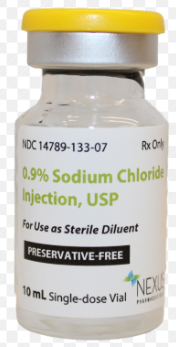
0.9% SODIUM CHLORIDE INJECTION USP Price
Active Substance: Sodium chloride.
Overview
Welcome to Dwaey, specifically on 0.9% SODIUM CHLORIDE INJECTION USP page.
This medicine contains an important and useful components, as it consists of
Sodium chlorideis available in the market in concentration
Name
Sodium chloride
Precaution
<ul> <li><strong>Electrolyte Imbalance:</strong> Use with caution in patients with conditions that predispose to sodium retention or electrolyte disturbances.</li> <li><strong>Renal Impairment:</strong> Impaired sodium excretion may lead to fluid overload and hypernatremia.</li> <li><strong>Cardiovascular Disease:</strong> Use cautiously in patients with congestive heart failure or hypertension due to risk of volume overload.</li> <li><strong>Liver Disease:</strong> Cirrhotic patients are at increased risk of fluid retention and ascites.</li> <li><strong>Pulmonary Edema:</strong> Risk is increased with high-volume infusions or impaired cardiac function.</li> <li><strong>Monitor Serum Electrolytes:</strong> Particularly with prolonged use or large volumes.</li> </ul>
Indication
<ul> <li><strong>Fluid and Electrolyte Replacement:</strong> Treats dehydration, hypovolemia, and electrolyte imbalances.</li> <li><strong>Vehicle for Drug Delivery:</strong> Diluent or solvent for parenteral drugs.</li> <li><strong>Wound Irrigation:</strong> Used in sterile irrigation procedures.</li> <li><strong>Maintenance Therapy:</strong> Helps sustain adequate hydration in surgical or critically ill patients.</li> <li><strong>Flush Solution:</strong> For intravenous lines to prevent blockage.</li> </ul>
Contra indication
<ul> <li><strong>Hypernatremia:</strong> Pre-existing elevated sodium levels.</li> <li><strong>Fluid Overload:</strong> Conditions like pulmonary edema or CHF where fluid retention is harmful.</li> <li><strong>Severe Renal Impairment:</strong> Risk of sodium accumulation and overload.</li> <li><strong>Hypersensitivity:</strong> Rare but possible; caution with allergic reactions.</li> </ul>
Side Effect
<ul> <li><strong>Common:</strong> Local site reactions including pain, redness, and swelling at infusion site.</li> <li><strong>Electrolyte Disturbances:</strong> Hypernatremia, hyperchloremia, or metabolic acidosis with prolonged or excessive use.</li> <li><strong>Fluid Overload:</strong> Hypertension, edema, or pulmonary congestion.</li> <li><strong>Rare:</strong> Phlebitis, thrombosis, or febrile reactions.</li> </ul>
Pregnancy Category ID
Information not available
Mode of Action
<p>Sodium chloride acts by:</p> <ul> <li><strong>Maintaining Osmotic Pressure:</strong> Helps balance fluid between body compartments.</li> <li><strong>Electrolyte Restoration:</strong> Replaces lost sodium and chloride ions, which are essential for nerve conduction, muscle contraction, and acid-base balance.</li> <li><strong>Volume Expansion:</strong> Increases extracellular fluid volume in hypovolemic states.</li> </ul>
Interaction
<ul> <li><strong>Corticosteroids:</strong> May enhance sodium and fluid retention.</li> <li><strong>Diuretics:</strong> May alter sodium levels; monitor for hypo/hypernatremia.</li> <li><strong>NSAIDs:</strong> May reduce renal sodium excretion, increasing risk of fluid retention.</li> <li><strong>Antihypertensives:</strong> Sodium chloride may counteract their effects.</li> </ul>
Pregnancy Category Note
<ul> <li><strong>FDA Category:</strong> Not formally assigned (generally considered safe when used appropriately).</li> <li><strong>Use in Pregnancy:</strong> Considered safe for use in pregnancy when medically necessary and administered under supervision.</li> <li><strong>Use in Lactation:</strong> No known risk; sodium is a natural component of breast milk.</li> </ul>
Adult Dose
<ul> <li><strong>IV Infusion:</strong> Typically 500 mL to 1000 mL depending on indication (e.g., dehydration, shock).</li> <li><strong>Rate:</strong> Adjusted based on clinical condition, cardiac function, and fluid status (e.g., 1–2 mL/kg/hr).</li> </ul>
Child Dose
<ul> <li><strong>Maintenance:</strong> Typically 20–60 mL/kg/day depending on age and clinical condition.</li> <li><strong>Bolus:</strong> For volume resuscitation, 10–20 mL/kg over 20–60 minutes as needed.</li> </ul> <p>Always titrate based on weight, fluid status, and electrolyte monitoring.</p>
Renal Dose
<ul> <li><strong>Mild to Moderate Renal Impairment:</strong> Use with caution; monitor electrolytes and fluid balance closely.</li> <li><strong>Severe Renal Impairment:</strong> May require dose reduction or slower infusion to prevent fluid overload or hypernatremia.</li> </ul>
Administration
<ul> <li><strong>Route:</strong> Intravenous infusion via peripheral or central line.</li> <li><strong>Infusion Time:</strong> As per clinical indication; rapid for resuscitation or slow for maintenance.</li> <li><strong>Inspection:</strong> Use only if solution is clear and free from particulates; ensure the container is intact.</li> <li><strong>Sterility:</strong> Use aseptic techniques; discard unused portion after opening.</li> </ul>
